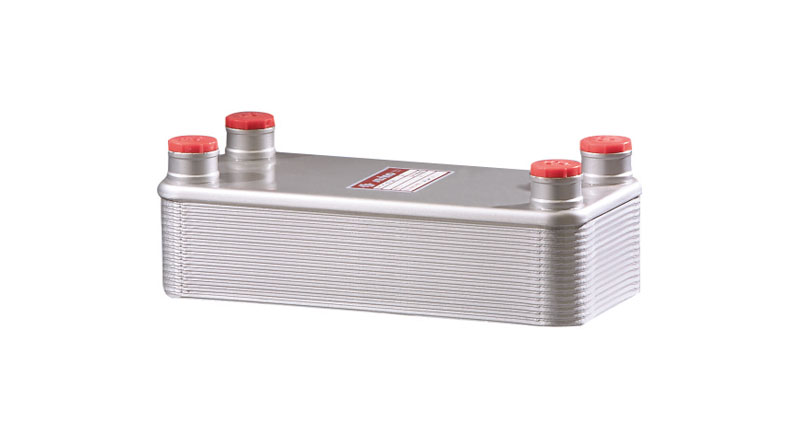WATER-OIL HEAT EXCHANGERS WITH BRAZED PLATES (M)
CONSTRUCTIVE AND WORKING PRINCIPLES
The heat exchanger with brazed plates consists of pressed stainless steel plates, which are brazed with copper alloy during a vacuum process.
During the brazing process, the plates are packed by turning them to 180° one to each other in order to create two separate flow chambers, where the fluids, which must exchange heat, flow in opposite directions.
The pressing on the plates causes a great turbulence in the fluids; this increases the thermic exchange coefficients even in case of little volumetric flows.
ADVANTAGES
• Compact and light unit
• High thermic exchange coefficient thanks to the particular structure of the plates
• High working temperature and pressure
• High corrosion strength (the plates are made of stainless steel)
• Simple installation and repair; it does not need maintenance
• Cheapness thanks to the possibility to automate the production
RESISTANCE TO INCRUSTATIONS
The brazed plate heat exchangers are much more resistant to the incrustations that occur on the water-side of the tube bundle heat exchangers.
This depends on the following factors:
• There is always a turbulent flow also in case of low water flows
• There are no areas with low speed, because water is distributed uniformly inside the exchanger
• The calcareous sediments cannot adhere on the plate surfaces, thanks to their accurate finishing.
The maximum working pressure is 30 bar. The working temperature is included between –160° and +225°C. The maximum difference between the temperatures of the fluids is 100°C. For each type of exchanger, the thermic performance’s curves, as a function of the oil rate, show the heat quantity in kW or in kcal/h that the exchanger is able to dissipate for each degree of difference between the inlet temperatures of water and oil.
The performance diagrams have been calculated with a ratio between the oil and the water flow rates of 2/1; for higher ratios, therefore for lower water consumptions, it is necessary to multiply the factors obtained from the curves by the following Ka coefficients.

The pressure drop and performance diagrams are valid for oil ISO VG46; for different types of oil, it is necessary to multiply the value obtained from the curves for the Kc coefficients, by the performance diagrams, and Kp by the pressure drop diagrams.

For the exact calculation of the exchangers with brazed plates into the oleohydraulic field, Sesino SpA is able to supply the customer with a calculation program on CD-rom, containing all the above mentioned variables. By filling in some data, it is possible to choose the necessary exchanger and to obtain on a data sheet all the working parameters.
The exchangers with plates can be used with other types of fluids, but these must be compatible with copper, which is the metal used for the brazing of the plates.
For each use, with the exception of oil cooling, it is recommended to consult our Technical Department.


